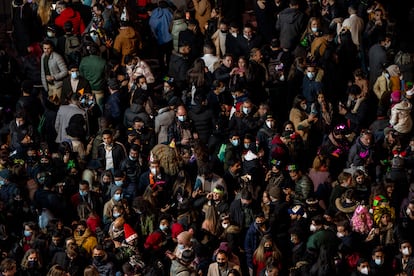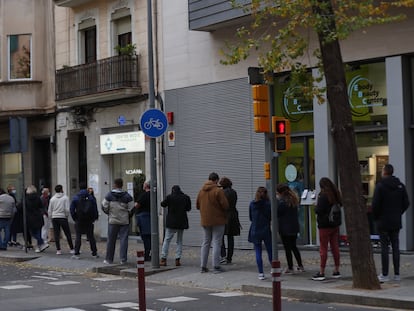Sixth coronavirus wave in Spain continues to spike, with record 372,000 new cases over New Year weekend
Latest data shows the highest growth in infections since the pandemic began, with levels far above those seen last week after Christmas. Hospitalizations are also rising

With Christmas and New Year now over, the sixth wave of the coronavirus pandemic is still breaking records in Spain. After three days with no official data, due to the weekend and New Year’s Eve on Friday, the Health Ministry last night reported 372,766 new infections detected since Thursday, pushing the cumulative incidence to 2,295 cases per 100,000 inhabitants in the previous 14 days. This is a spike in the indicator of 520 points, and represents the biggest rise since the pandemic began. The growth in cases is much more marked this week than last, after Christmas, when the incidence rose 295 points and 215,000 infections were detected.
Hospitalizations are also on the rise. On Monday, there were 12,339 Covid-19 patients who were occupying 10.1% of beds, compared to 9,350 a week ago. The patients in intensive care units (ICUs) have also risen to 1,974 – 21.2% occupation. A total of 168 Covid-19 deaths were added to the overall toll, which now stands at 89,573.
While the wave is still rising, the data are ever less homogeneous and comparable. The overload of the healthcare system due to the huge explosion in infections has prompted a change in protocols, which now do not require the tracing of close contacts nor diagnostic tests for these contacts if they do not have symptoms. This, combined with the large numbers of citizens who are resorting to home-testing antigen kits from pharmacies, means that many infections are not being included in the official statistics.
In fact, according to Salvador Peiró, an epidemiologist and head of research at the Fisabio foundation in Valencia, the infection figures “cannot be interpreted.” He adds: “Everything is going to be very confusing. We need to look at the information from the hospitals, they are the only ones we can trust, but these are figures that have a certain delay. By the time you see them, the situation is already upon us,” he explains.
The infection data for all of the country’s regions – which are in control of their coronavirus restrictions, vaccination drives and healthcare systems – are at never-before-seen levels. The cumulative incidence is in excess of 5,500 cases per 100,000 inhabitants in Navarre, which tops the list by a large margin. It is followed by the Basque Country (4,412) and Aragón (3,440). Only Andalusia (1,482) is below 1,500.
That said, as Peiró points out, comparisons between regions are not that rigorous because each one is reporting cases in a different way under the new protocols. Catalonia, for example, has started to use a system whereby pharmacies can report positives detected via home-testing kits.
The number of hospital admissions is proving to be much slower in proportion with infections compared to other waves. Much of this phenomenon is due to the high levels of vaccination coverage in Spain, as well as the possibility that the highly contagious omicron variant is also less virulent – it is yet to be established, however, to what extent this is true among people who are not vaccinated.
The growth in cases is so explosive, however, that occupation in hospitals is already 20% above the maximum level seen in the fourth and fifth waves. These two spikes, which had much fewer cases than the one right now (the incidence peaked at 235 and 700, respectively) did not cause major disruptions to the health system, apart from some isolated cases.
The problem now is that the wave is still growing and no one knows when it will peak. While the proportion of infections that end up in hospital beds might well be low, the number of ICU patients is such that these units are at risk of problems. There are already hospitals where non-urgent surgeries are being postponed, and this could become a generalized issue in the coming weeks.
The tens of thousands of cases that are being registered this Christmas are, in their vast majority, mild. The few that are ending up in hospital will take an average of between eight and 10 days to require hospitalization after diagnosis, and between two and three weeks before they reach the ICU, assuming that they need such emergency care. This means that the pressure on hospitals is likely to continue to grow during much of the month of January.
According to the calculations by Álex Arenas, a professor of computer science and mathematics at the Rovira i Virgili university, the peak of this wave is likely to be reached in mid-January. “The fall will likely be quick, as was the rise, but the hospitals are facing very tough weeks,” he explains. The majority of infections caused by the omicron variant are still not being reflected in hospital occupation figures, something that will begin to happen this week and the next. “We will return to having high pressure on hospitals, and many healthcare workers will be off sick,” he explains. “With so many infections and fewer staff, it’s going to be a problem.”
Salvador Tanche, president of the Spanish Society of Family and Community Medicine (SEMFYC), believes that in the short term “the forecast is bad.” “A rise in cases due to Christmas and New Year lunches and dinners is expected,” he explains. He currently sees four services that are overwhelmed: primary healthcare, contact tracers, the emergency rooms and microbiology laboratories.
“What’s needed, and it is already happening, is a change in the way of managing this wave, given that it is much milder than others, but more infectious; it makes the work of tracing, contact studying and diagnostics all useless. We need to manage the pandemic like we manage the flu: mild symptoms are even more so when people are vaccinated, so self-care; moderate cases should consult with their family doctor; and for those more serious cases, they should go to hospital,” Tranche argues.
Omicron
One of the enigmas yet to be resolved is the death rate of omicron. With so many of the infections concentrated in the last two weeks, there has still not been time for the illness to take its course and cause the deaths of the most vulnerable patients. Thanks to the data from other countries, and the known effectiveness of the vaccines, there is no doubt that the lethality of this new variant will be lower than that of previous strains. But as is the case with hospitalizations, a very high number of cases can also cause a number of fatalities.
This data point is the one with the longest delays – not only because it is the end of the process (after infections, hospitalizations and ICU, should these steps be necessary), but also because reporting delays mean that it is not clear exactly how many people have died in a given day until weeks later. The Health Ministry has reported 249 Covid-19 fatalities in the last week, a figure that will no doubt rise once the data has been updated.
Tu suscripción se está usando en otro dispositivo
¿Quieres añadir otro usuario a tu suscripción?
Si continúas leyendo en este dispositivo, no se podrá leer en el otro.
FlechaTu suscripción se está usando en otro dispositivo y solo puedes acceder a EL PAÍS desde un dispositivo a la vez.
Si quieres compartir tu cuenta, cambia tu suscripción a la modalidad Premium, así podrás añadir otro usuario. Cada uno accederá con su propia cuenta de email, lo que os permitirá personalizar vuestra experiencia en EL PAÍS.
¿Tienes una suscripción de empresa? Accede aquí para contratar más cuentas.
En el caso de no saber quién está usando tu cuenta, te recomendamos cambiar tu contraseña aquí.
Si decides continuar compartiendo tu cuenta, este mensaje se mostrará en tu dispositivo y en el de la otra persona que está usando tu cuenta de forma indefinida, afectando a tu experiencia de lectura. Puedes consultar aquí los términos y condiciones de la suscripción digital.
More information
Últimas noticias
Imelda Castro, the woman who wants to rule the cartel battleground of Sinaloa
The new victims of the Republican war on Obamacare: Millions hit by soaring health insurance premiums
A country divided on migrant rights: Some US states expand protections while others restrict them
Venezuela authorizes the release of another 87 political prisoners
Most viewed
- David King, chemist: ‘There are scientists studying how to cool the planet; nobody should stop these experiments from happening’
- Reinhard Genzel, Nobel laureate in physics: ‘One-minute videos will never give you the truth’
- Oona Chaplin: ‘I told James Cameron that I was living in a treehouse and starting a permaculture project with a friend’
- Sinaloa Cartel war is taking its toll on Los Chapitos
- The Interoceanic Train, the Mexican alternative to the Panama Canal











































